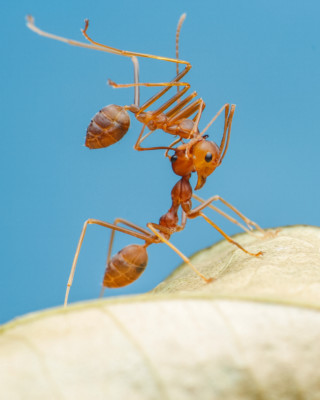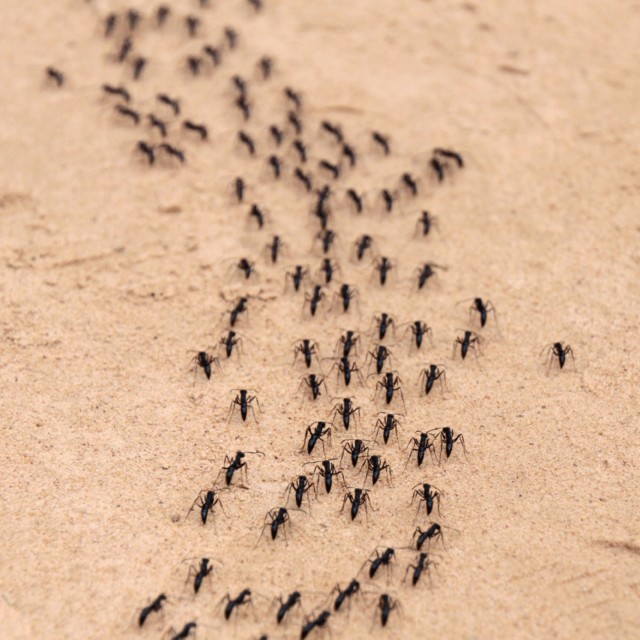The Crawling Crew: A Guide to Common UK Ants
It’s always nice to see the summer arrive…but the warmer months aren’t without their challenges. As the sunshine appears, so do certain pests – including ants.
These tiny creatures can quickly become a big problem, so it’s important to be prepared. Understanding the different UK ant species can help with effective pest control, allowing you to better prevent and manage infestations.
Read on for a guide to the most common UK ant species, their behaviours, their impact on our homes and gardens, and our top prevention tips.
Key Ant Species Overview
Did you know that there are more than 50 UK ant species?
It’s unlikely that you’ll see that many, though. Here’s a short guide to the top six you’re likely to spot.
Black Garden Ant (Lasius niger)
If you’re finding ants in your house, black ants are often the culprit. They’re black-brown in colour and their waists tend to have a nipped-in appearance – the flying adult black ants, though, are bigger and more brown in colour.
Black garden ants nest in all sorts of places, including in lawns and under pavements and patios. Here, their colonies reach an average of 4,000-7,000 workers, so they can quickly become problematic.
While they often eat insects, black ants also have a sweet tooth. They nibble on fruit and nectar, and will happily tuck into any human food and drink they can get hold of.

Black Stinging Ant (Tetramorium caespitum)
Worker black stinging ants are dark brown or black with pale legs and around 2.5-4mm in length. They may be small but they’re aggressive, using their sting frequently and establishing dominance when there are other ant species around.
In the UK, they’re generally found along the Western and Southern coastlines. They nest in rock crevices, under stones and in sandy or peaty ground, and their colonies average 10,000 workers. These ants are predators and will eat other insects, as well as seeds and fruits.

Common Red Ant (Myrmica rubra)
The common red ant is one of seven species of red ants in the UK. Red in colour, they can be distinguished from other red ants by their shorter spines. These ants have colonies of around 1,000 workers and an average of 15 queens. While they prefer damp, warm places like river banks and meadows, they’ll also nest in gardens, parks and woodland under stones, in tufts of grass and in rotten wood.
These aggressive ants sting freely. They feed on aphids and other insects (including spiders), as well as nectar from flowers.

Carpenter Ant (Formica ligniperda)
Carpenter ants are often on the large side – up to half an inch long – and are normally blackish in colour. As you’d expect from their name, they tend to hollow out wood to nest in. When it comes to pest control, ants like these are important to control.
They prefer moist wood: places like around sinks and bathtubs, in the fabric of the roof, and in wall voids behind dishwashers and washing machines. When it comes to nesting, carpenter ants actually form two types of nest: a parent colony, which contains the queen, her brood and around 2,000 or more workers, and satellite colonies, home to large numbers of workers only. They feed on fruits, plant sap, nectar and honeydew produced by aphids.

Yellow Meadow Ant (Lasius flavus)
Yellow-brown in colour and 2-4mm long, yellow meadow ants are often mistaken for red ants because of their colouring. These ants actually spend most of their lives underground, in nests that can extend to a metre below the surface.
You’ll find their nests in grassland and downlands – as well as in gardens if you let your grass grow too long. You’ll recognise yellow meadow ant nests from the anthills they form above their nests – these help to regulate the nest’s temperature and humidity. They tend to feed on honeydew produced by aphids and they’re very sociable – but you’re unlikely to see them unless their nests are disturbed.

Red Wood Ant/Horse Ant (Formica rufa)
Known as red wood ants, horse ants and southern wood ants, these ants are aggressive predators. This UK ant species lives in woodland, as well as on moorland and heathland. Measuring up to 1cm long, they are one of many UK wood ant species, which can be hard to distinguish from each other.
Red wood ants have dark heads and orange-black bodies and large biting jaws. They can spray formic acid as a means of defence, and feed on all sorts of invertebrates. Their colonies can reach up to around half a million ants, living in nests formed from twigs, pine needles, soil and leaves.


The different environments that each of these UK ant species prefer to live in influences their presence around human habitats. With red wood ants preferring woodland and heathland, they tend to be unproblematic for humans. Others, though, prefer gardens and damp wood, and this – along with the sweet tooth that many ant species possess – can result in unwanted infestations close to home.
Many ants – like black ants – love to forage, and a number of species are attracted by sugar. If they find food or drink spills, crumbs or the remnants of an indoor or outdoor meal, they can soon swarm to enjoy the food source you’ve left for them.
Nesting colonies of ants can reach their thousands – even up to half a million in the case of red wood ants. This not only means a great deal of mating activity is likely, it also means that when it comes to pest control, ants can be challenging to manage. What’s more, they can also have a significant negative impact on your home and garden.
Impact of Ants on Homes and Gardens
Different ant species can affect households and garden areas in different ways. Yellow meadow ants can destroy your lawn with their anthills, while many others can also nest in lawns and under paving slabs and their numbers can quickly get out of control. If you have a colony of biting or stinging ants living in your garden, they can pose a risk to both human inhabitants and pets. Look out for carpenter ants, too, which can destroy the structure of your home or garden outbuildings.
Black garden ants and others can enter your home in search of food sources, contaminating your food and causing distress – once they’re there, they can be hard to get rid of without dedicated pest control for ants.
There are signs of ant infestations you can watch out for so you can tackle the issue quickly. These can include mounds of earth on your lawn, sand pushed up between paving slabs and seeing lines of ants marching through your garden. As ants don’t hide from humans (they don’t associate us with danger like some other pests do), an infestation is generally pretty easy to spot. The next challenge? Dealing with that infestation…
Control and Prevention Tips
When it comes to pest control for ants, prevention is always better than cure. Find and seal any potential entrances to your home, such as spaces under doors, foundation gaps and cracks in walls – remembering that ants can get through the tiniest of gaps. Sprinkle talcum powder to prevent ants from coming in, and if you see a solitary ant in your house, kill it – it’s likely that it’s scouting for food before it brings more of the colony inside.
Ensure that food and drink is stored properly, as well as cleaning up spillages and crumbs. There are also certain home remedies that can work – such as spraying lemon juice or a solution of vinegar and water to deter ants from your property.
Some suggest pouring boiling water onto ant nests in your garden, but this won’t necessarily work. The water will cool down quickly as it touches the ground, plus it’s unlikely that it will kill the entire colony – and it could damage surrounding plants.
Off-the-shelf solutions like ant sprays, ant powders and bait traps can be successful, but may not be safe to use in properties where pets and/or children are present. If you’re struggling to deal with ant infestations with natural methods or shop-bought products, it may be time to call in the professionals.
One thing to remember is that it is important to identify the ant species you are dealing with before attempting to destroy the nest so that you can choose the most effective control strategy possible.
Further Guidance and Services
If your ant problem is trickier to resolve than ant-icipated, it may be time to call for back up. At Pest Stop Boys, we’re well-versed in pest control for ants, with a wide variety of solutions to suit every situation. When it comes to insect pest control, we always use safe and reliable solutions, and consider the environment, pets and children in our approach.
With fantastic Checkatrade reviews, discreet, unbranded vehicles and a professional approach, we’re here to help. Contact us for a professional consultation to see how we can help.

